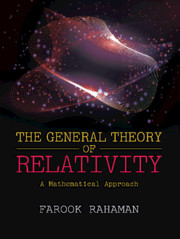Book contents
- Frontmatter
- Dedication
- Contents
- List of Figures
- List of Tables
- Preface
- Acknowledgments
- Chapter 1 Tensor Calculus — A Brief Overview
- Chapter 2 Geodesic
- Chapter 3 Einstein Field Equations
- Chapter 4 Linearized Gravity
- Chapter 5 Lie Derivatives and Killing’s Equation
- Chapter 6 Spacetimes of Spherically Symmetric Distribution of Matter and Black Holes
- Chapter 7 Particle and Photon Orbits in the Schwarzschild Spacetime
- Chapter 8 Causal Structure of Spacetime
- Chapter 9 Exact Solutions of Einstein Equations and Their Causal Structures
- Chapter 10 Rotating Black Holes
- Chapter 11 Elementary Cosmology
- Chapter 12 Elementary Astrophysics
- Appendix A Extrinsic Curvature or Second Fundamental Form
- Appendix B Lagrangian Formulation of General Relativity
- Appendix C 3+1 Decomposition
- Bibliography
- Index
Chapter 12 - Elementary Astrophysics
Published online by Cambridge University Press: 24 March 2021
- Frontmatter
- Dedication
- Contents
- List of Figures
- List of Tables
- Preface
- Acknowledgments
- Chapter 1 Tensor Calculus — A Brief Overview
- Chapter 2 Geodesic
- Chapter 3 Einstein Field Equations
- Chapter 4 Linearized Gravity
- Chapter 5 Lie Derivatives and Killing’s Equation
- Chapter 6 Spacetimes of Spherically Symmetric Distribution of Matter and Black Holes
- Chapter 7 Particle and Photon Orbits in the Schwarzschild Spacetime
- Chapter 8 Causal Structure of Spacetime
- Chapter 9 Exact Solutions of Einstein Equations and Their Causal Structures
- Chapter 10 Rotating Black Holes
- Chapter 11 Elementary Cosmology
- Chapter 12 Elementary Astrophysics
- Appendix A Extrinsic Curvature or Second Fundamental Form
- Appendix B Lagrangian Formulation of General Relativity
- Appendix C 3+1 Decomposition
- Bibliography
- Index
Summary
Stellar Structure and Evolution of Stars
“Twinkle Twinkle little star
How I wonder what you are!!”
Everyone, whether he or she is literate or illiterate, has a query what the stars are!
Our universe consists of billions of galaxies of various shapes: elliptical, spiral, irregular, etc., and the universe contains 1011 galaxies and each galaxy consists of 1011 stars. We live in a spiral galaxy visible in the night sky, known as Milky Way. It is convex shaped with diameter, 105 l.y. and thickness about 5000 l.y.
The apparent brightness and color serve as the characteristics for identifying a star. All stars do not have the same brightness. In second-century BC, the Greeks had grouped naked eye visible stars into six classes, called the magnitudes [brightest, the first magnitude; faintest stars being the sixth magnitude].
All measurements of the brightness and other characteristics of a star are relative, i.e., one has to compare either two stars with each other or a star with an artificial standard source of light. For easy access, people use the sun as standard one, mass: M⊙ = 1.98892 × 1030 kg, diameter: 1,391,000 km, radius: R⊙ = 695, 500 km, the surface gravity of the sun: 27.94 g, volume of the sun: 1.412×1018 km3, the density of the sun: 1.622×105 kg/m3, luminosity of sun L⊙ = 3.846×1026 W.
Before 1840, people used the eye; in 1840-1940, people used the photographic method. From 1940 onwards, people use the photoelectric method (Fig. 104) to measure the brightness (light) of a star. For the latter case, starlight is allowed to fall on the cathode of a photocell and the resulting photocurrent is amplified and recorded on a pen recorder. The deflection is then directly proportional to the intensity.
Two of the basic observable parameters in stars are:
(i) The luminosity L (or absolute magnitude M)
(ii) The effective temperature TE (or spectrum)
In the years 1911 and 1913, two scientists Hertzsprung and Russell individually observed that the luminosities and surface temperatures of stars are interrelated. This interrelation is generally demonstrated in a two-dimensional diagram, known as Hertzsprung–Russell or H-R diagram in which the vertical axis represents the luminosity and the horizontal axis represents the surface temperature (Fig. 105). The stars can be identified by a point with coordinate (TE, L) on this diagram.
- Type
- Chapter
- Information
- The General Theory of RelativityA Mathematical Approach, pp. 345 - 378Publisher: Cambridge University PressPrint publication year: 2021



